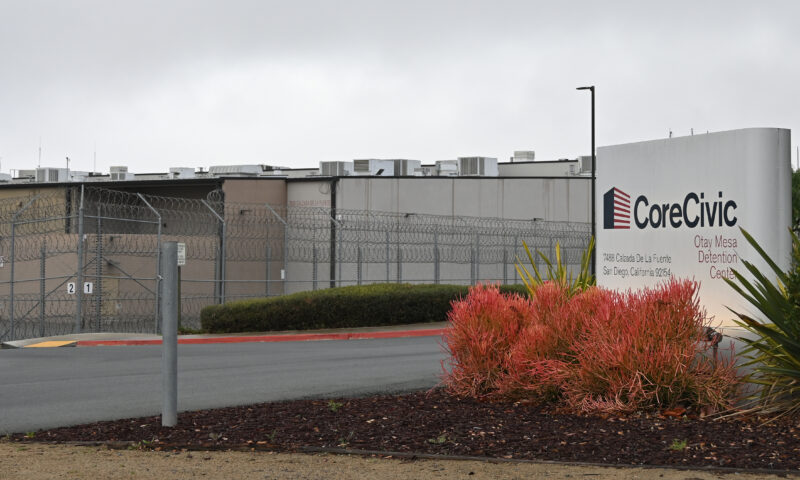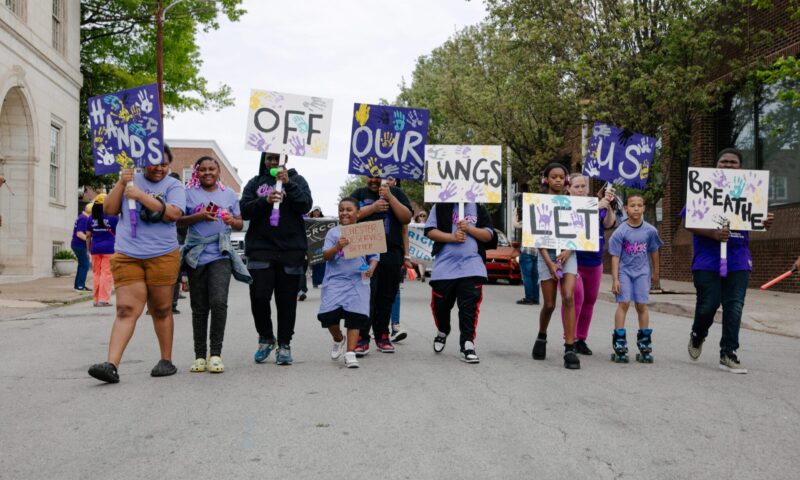Moving the Needle
Science Supports Supervised Injection Sites. Why Don’t Politicians Agree?
Safe injection facilities represent the highest ideal of harm reduction services for people who inject drugs, yet in the United States remain almost prohibitively controversial.

Any state that opens a supervised consumption site risks running afoul of federal law. Yet several U.S. cities and nonprofits plan to go ahead with the facilities anyway.
Harm reduction for drug users, which includes everything from distributing clean needles to HIV testing to supervised injection sites, has shown to be one of the most effective strategies for slowing the spread of disease and lowering overdose rates. In some parts of California, however, the approach remains misunderstood and controversial. This week our three-part series, “Moving the Needle,” looks at the obstacles faced by harm reduction organizations in rural Northern California.
Monday Judith Lewis Mernit reported from Ukiah, where people who use drugs find acceptance and community without stigma or shame. Tuesday Mernit described how a model harm reduction center divides the city of Eureka — but also saves lives.
Today: Safe injection facilities are at the front line of a health-care revolution for drug users — and of a potential showdown with the Trump administration.
Somewhere in the U.S., at a location disclosed only to a select few, there exists a clean, bright room where people sit in comfortable chairs and inject illegal drugs with sterile equipment, under the watchful eyes of caring staff. They bring their own drugs, obtained on the street or through a dealer, and can test them, if they choose to, for the presence of fentanyl, a dangerously powerful synthetic opioid often mixed into heroin supplies (and possibly methamphetamine as well). They can relax, take the time to clean the injection site thoroughly with an alcohol wipe, find a useful vein without having to hurry.
When they are done injecting, they safely dispose of their syringes in a biohazard box and move into an adjoining room, where they continue to be monitored for signs of overdose. If a person nods off, appears to have trouble breathing, or turns pale and clammy, a trained technician can administer naloxone, an opioid overdose-reversal drug, and save that person’s life. In this one facility’s four-year history, 18 overdoses have been reversed, according to Alex Kral, an infectious disease epidemiologist in San Francisco with the nonprofit research agency RTI International.
In a dozen countries — including France, the Netherlands and Australia — only one fatal overdose has ever been associated with supervised consumption.
Supervised consumption sites, also called safe injection facilities or SIFs, represent the highest ideal of harm reduction services for people who inject drugs. While syringe-exchange programs help reduce the spread of blood-borne diseases such as HIV and hepatitis C, and naloxone distribution among first responders, community members and the drug users themselves helps reduce overdose deaths, supervised consumption sites virtually eliminate fatalities.
Among the 120-some SIFs that have operated legally, some for more than 20 years, in a dozen countries — including France, the Netherlands and Australia — only one fatal overdose has ever been associated with supervised consumption. (That one death, which happened later at a hospital near a SIF in Canada’s capital city, Ottawa, may have been caused by a heroin supply adulterated with a fentanyl analog such as carfentanil, a drug used to sedate elephants.)
The sites have also been found to have a positive, or at least neutral, impact on drug-related crime and violence in the neighborhoods where they exist. Supervised consumption in a contained facility could also address the biggest problem communities say they have with syringe-exchange programs, which is that, whether or not the exchange is to blame, needle litter turns up in playgrounds and parks. “I talked to a police captain here in San Francisco,” Kral reports, “and he said, ‘You mean the drug users go in a building, inject their drugs, and the needles stay there when they leave? I’m in!’”
Supervised consumption sites, like syringe-exchange programs, also serve as a point of connection with health care for people with substance use disorders who want to stop, or at least change the way they use drugs — which includes nearly everyone who uses drugs. “Most people are thinking every day, ‘I’ve got to stop using drugs. I’m going to die like this,’” says Barry Zevin, medical director of Street Medicine and Shelter Health in the city of San Francisco. “But it’s really hard to walk into a treatment program and ask for help when you’re actively using.” Much better to go to where people are using, in the places where they feel comfortable, maybe even safe.
Nevertheless, supervised consumption sites in the United States remain almost prohibitively controversial. Last year, a California bill that would have authorized pilot programs in eight counties with high overdose rates — Humboldt and Mendocino among them — failed in the state legislature. This session, the bill’s authors, Assemblymember Susan Eggman (D-Stockton) and state Senator Scott Wiener (D-San Francisco), pared down their ask to a single four-year experiment in San Francisco, and rebranded it as an “overdose prevention” bill. It passed both houses, only to die by Governor Jerry Brown’s pen.
Within two years of its 2003 opening, North America’s first supervised consumption site, in Vancouver, Canada, was associated with a 30 percent increase in detox enrollment.
Brown’s press secretary, Evan Westrup, claims the Governor acknowledged the research on supervised consumption when he wrote, in his September 30 veto letter, that “The supporters of the bill believe these ‘injection centers’ will have positive impacts, including the reduction of deaths, disease and infections resulting from drug use.” But “the governor also considered the views of those opposed to the legislation,” including law enforcement and drug court judges. “After weighing both sides,” Westrup wrote in an email, “[the governor] ultimately concluded that” — as he wrote in the letter — “the disadvantages of this bill far outweigh the possible benefits.”
“I do not believe,” reads the veto letter, “that enabling illegal drug use in government sponsored injection centers — without any corresponding requirement that the user undergo treatment — will reduce drug addiction.”
“Nobody wakes up one morning and says, ‘Hey, there’s this supervised consumption site in my neighborhood! I’m going to go and inject drugs now.’”
But the supporters of the bill aren’t relying on anything so malleable as belief. Instead they cite decades of scientific research demonstrating that supervised consumption sharply reduces the incidence of death, disease and infection among injection drug users. There is also ample evidence that coercive treatment fails, 12-step programs work only five to 10 percent of the time, and supervised consumption often serves as a pathway to voluntary treatment. Within two years of its opening in 2003, North America’s first supervised consumption site, Insite in Vancouver, Canada, was associated with a 30 percent increase in detox enrollment. Later studies have confirmed that the trend continues.
Nor is there evidence to support the claim that supervised consumption “enables” drug use. “There’s nobody who wakes up one morning and says, ‘Hey, there’s this supervised consumption site in my neighborhood! I’m going to go and inject drugs now,’” says Kral, who with Peter Davidson of the University of California, San Diego, is one of two researchers allowed in to study the clandestine supervised consumption site.
In fact, he says, the people who access the facilities “are people who’ve been injecting for a long time and have to come to some sort of terms with the fact that it’s gotten so bad that they’re willing to go to one of these places. It’s not like stepping into a bar. These aren’t fun late-night hangouts. They’re not enabling people to do anything.” Except stay alive.
“That’s what it all comes down to,” Kral says. “The first thing you’ve got to do is keep them from dying. Then let’s think about treatment and all of the other options.”
Kral remembers a time when the “enabling” argument was used against another harm reduction effort, the distribution of the overdose-reversal drug naloxone. “The words people used back then were, ‘This is a parachute drug. You’re giving people a parachute, so now they’re going to think it’s fine to jump off planes.’” That criticism has fallen away as the crisis has grown more severe, but it still persists in some circles, as does the idea that people who use drugs have no agency to make decisions for themselves.
If it hadn’t been for opioids, the country would still be in a crisis of substance use disorders. Only the substances would be different.
Elinore McCance-Katz, the assistant secretary for mental health and substance use at the Substance Abuse and Mental Health Services Administration (SAMHSA), recently wrote that she opposes fentanyl test strips on the grounds that “people who are severely addicted will actually use the test strips to seek fentanyl, which might be able to give them the high that their current opioid no longer gives them.”
It’s that kind of “paternalistic attitude,” Kral says, that often stands in the way of services that can protect the health of people while they’re using drugs. But it also reflects a misunderstanding of how and why people get high. Leo Beletsky, an associate professor of law and health sciences at Northeastern University, argues that the nationwide opioid crisis wasn’t born simply of a loose prescribing environment for new and misleadingly marketed painkillers. It happened because those drugs became available during a time when people were feeling the sting of shrinking incomes, home foreclosures and disappearing opportunities.
“Opioids were the spark,” he says, “but broader societal changes created the fuel. The decline of unionization, poor job conditions, the dismantling of public assistance — all of it gets swept under the rug with this simplistic view of opioids being the causal factor.” If it hadn’t been for opioids, the country would still be in a crisis of substance use disorders. Only the substances would be different.
There already exist injection sites in every city, town and county: They’re called public bathrooms.
It’s worth remembering that, decades before opioids were a national obsession, overdose rates were already at crisis levels in urban communities of color, as well as in certain desperately poor counties in Appalachia and New Mexico. “Opioids were able to penetrate communities that would have been more likely to use alcohol, or other substances, like Valium,” Beletsky says. And “the use of benzodiazepines and amphetamines is [also] through the roof” right now.
As is the use of heroin and fentanyl. One of the consequences of restricting the prescription drug supply has been a sharp uptick in the use of far more dangerous street drugs. In 2015, law enforcement personnel who submitted illicit drugs for testing found twice as many tainted with fentanyl as they’d found the year before.
The discussion we should be having then, Beletsky continues, “isn’t an opioids-only discussion,” based on the idea that opioids are a contagion that needs to be contained. “It’s a discussion about our physical and mental health as a nation.”
Governor Brown was right about one thing in his letter: Any state that opens a supervised consumption site risks running afoul of federal law. The “crack house law,” enacted in 1986, prohibits maintaining “any place, whether permanently or temporarily,” for the purpose of using any controlled substance. In an August 27 New York Times opinion piece, Deputy U.S. Attorney General Rod Rosenstein promised “swift and aggressive action” against local jurisdictions that sanction supervised consumption facilities. He also claimed — again, without evidence — that SIFs “normalize drug use and facilitate addiction.”
Several U.S. cities and nonprofits plan to go ahead with the facilities anyway. San Francisco Mayor London Breed has been adamant that she won’t bow to state and federal authorities on the matter; Seattle’s Human Services Department is discussing a mobile supervised consumption site. Ithaca, New York has a site “fully outfitted and ready to go,” Kral says. New York City advocates have floated the idea of applying for a research license from both state and federal governments, in order to get around the legal constraints of opening a SIF.
In Philadelphia, the harm-reduction nonprofit Safehouse has already begun raising funds for what it calls an “overdose prevention site” (and which the regional U.S. Attorney calls a “deadly drug injection site”), with the support of former Pennsylvania Governor Ed Rendell. “It’s somewhat possible,” Rendell acknowledged to the Associated Press, that “they will come and arrest me.”
Or maybe they won’t. Beletsky has written that the law “was never intended to interfere with a legally authorized public health intervention,” which supervised consumption sites clearly are. After all, there already exist injection sites in every city, town and county: They’re called public bathrooms. And alleys, park gazebos and just about any place else one can find a place to hide. “We need to play that game where we require politicians to finish every sentence denouncing supervised injection facilities with the phrase, ‘and that is why I think injecting alone in a McDonald’s bathroom is better,’” wrote physician and harm reduction advocate Jonathan Giftos on Twitter.
“If you think this through at all, [the objections] are not about reality,” Alex Kral says. The science, he notes, is clear on the benefits for both the community of people who use drugs and the community of people who want drug use to stop. Everything else “is just politics.”
Judith Lewis Mernit’s reporting on harm reduction in rural California was supported by the USC Annenberg Center for Health Journalism’s 2018 Impact Fund.
Copyright Capital & Main

-

 Latest NewsJune 17, 2025
Latest NewsJune 17, 2025A Coal Miner’s Daughter Takes on DOGE to Protect Miners’ Health
-

 Beyond the BorderJune 10, 2025
Beyond the BorderJune 10, 2025Detained Man Says ICE Isn’t Treating His Colon Cancer
-

 Column - State of InequalityJune 5, 2025
Column - State of InequalityJune 5, 2025Budget Cuts Threaten In-Home Assistance Workers and Medi-Cal Recipients
-

 Column - State of InequalityJune 12, 2025
Column - State of InequalityJune 12, 2025‘Patients Will Suffer. Patients Will Die.’ Why California’s Rural Hospitals Are Flatlining.
-

 Column - California UncoveredJune 18, 2025
Column - California UncoveredJune 18, 2025Can Gov. Gavin Newsom Make Californians Healthier?
-

 Featured VideoJune 10, 2025
Featured VideoJune 10, 2025Police Violently Crack Down on L.A. Protests
-

 Latest NewsJune 4, 2025
Latest NewsJune 4, 2025Grace Under Fire: Transgender Student Athlete AB Hernandez’s Winning Weekend
-

 The SlickJune 6, 2025
The SlickJune 6, 2025Pennsylvania Has Failed Environmental Justice Communities for Years. A New Bill Could Change That.


